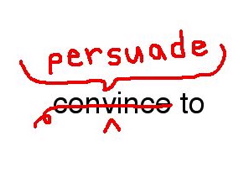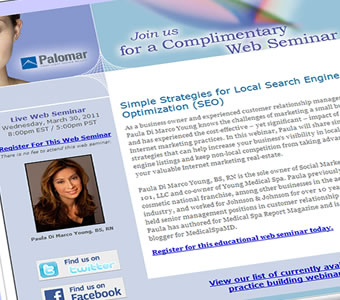
Is your medical spa's website causing potential patients to make the kind of decisions you want them to make?
Think about the last 10 decisions you have made. How did you come to your decisions?
You probably made a mental note of the pros and cons, factored in your intuition along with some sound logic and came up with an intelligent decision. You probably understand that most people aren’t as strong and smart as you and therefore are easy targets to sway. But, that never happens to you. You are just too smart.
You just made your first mistake. You experienced something called the “fundamental attribution error”. This is the belief that other people’s behavior is solely based on their personality, rather than external factors. For example, “Mary is late because she doesn’t care if others have to wait for her” verses “Mary is late because she must have had car trouble”.
These types of biases are very common and play a big role in the way decisions are made. So of course web designers are using this information to influence the behavior of users. Some designers intuitively know what techniques to use to achieve this, but they may not be able to tell you exactly “why” it works. However, there are some very skilled “decision architects” that understand the psychological behavior and intentionally design web sites with the goal of shaping a visitors decision process and guiding them into a specific action.
There are 7 main components in the decision architect’s toolbox: Authority, Commitment, Scarcity, Salience, Reciprocation, Framing and Social Proof.
#1 Authority:
This principle is about influencing behavior via credibility. This is why you will see a lot of name-dropping, used to give the reader confidence that this information is valuable and credible. The MD or DO afer your name is a prime example.
Readers are more likely to believe information if it is written by an “expert” in the field. In turn, they are more likely to act (buy) as a result of this information.
Decision architects exploit this principle by listing rave reviews and testimonials on their site. Patient testimonials are a common example that a lot of medical spas use. E-commerce sites show highly visible icons assuring the user that the site is secure. Forums are another way to use authority. People have the opportunity to rate their peers and users might rely on those ratings as if they were from an expert.
#2 Commitment:
This principle is about taking a stand on an issue that is consistent with our own beliefs. When you take a stand on something that is visible to other people, you usually feel a drive to maintain that point of view to appear credible and consistent.
Designers use this principle by asking for a small, but visible, commitment from you. If they can get you to behave in a certain way, you’ll soon start believing it. An example of this is Facebook. If a group page can get you to “like” their page and it appears on your newsfeed, you are basically recommending this to all your friends. If you can get a patient to “like” your medical spa fan page, you have “publicly committed” to being your fan.
#3 Scarcity:
This principle takes me back to some of the manufactured product scarcity around Botox and filler injections. The newspapers or press (or even a local doc) runs the headline “Botox shortage” and there are immediately lines around every block of people wanting to be seen. (Of course there is no Botox shortage and never will be.)
People are more likely to want something if they think it is in short supply or more valuable than it actually is. For example, psychologists have reported that if you give people a cookie from a jar, they rate the cookie as more delicious if it comes from a jar with only 3 cookies list verses a jar with 10 cookies. A nice fact and part of the reason that Fifth Avenue shoe stores put their shoes on pedistals in almost empty stores.
Decision architects exploit this by showing scarcity of a product. This could include limited treatment times or any number of 'act now' specials in your clinic. Smart medical spas understand that perceived scarcity will generate demand.
Another example of this might be a Grand Opening sale. How many medical spas keep that sign up for months and months, hoping that new customers will take advantage of the “special” price?
#4 Salience:
People are more likely to pay attention to details in your user interface that are unique such as a colored “continue shopping” button. For example, there are certain times during a purchase when consumers are more likely to investigate a special offer. Being able to understand this gives you an opportunity to sell more products or services by offering them at just the right time in the buying cycle.
#5 Reciprocation:
Do you like to return favors? Most people do and it’s this psychology that is the basis for this principle. If someone helps you paint your house or babysit your kids, you feel obligated to help them at a future date.
Decision architects know that if they offer you a small gift – a free newsletter, consultation, seminar, or a sample chapter from a book – you are very likely to do something for them in return, even if it's only positive word of mouth. At first they may not ask you to buy something. They may start by asking you to comment on their blog or link to a website. They know that it usually take several contacts with a user to make them an actual “customer”.
#6 Framing:
Savvy decision architects know that we like making choices. It makes up feel in control of our destiny. So, if we are given a choice of 3 tiers of products, you can be assured that there is one of them that they are pointing you towards whether you realize it or not. Another example of framing is the medical spa doc who shows you the most expensive 'total makeover' package knowing you can’t afford it. Then the next 'best bang for the buck treatments' seem like a real bargain in comparison!
#7 Social Proof:
Have you ever gone to lunch with a group of friends? Have you ever watched as everyone orders and then base your decision on their choices?
A great example of Social Proof is shopping on Amazon. When you buy a certain product, say a digital camera, Amazon will then post a note to you saying “other people who bought this camera bought this case and memory card”. Well, if other people bought them, you certainly should as well!
A medical spa example is a 'recommended treatment' for a patients age issue or skin type. A good decision architect will have the 'most patients like' add-on already checked. The client thinks, “I guess everyone buys this so I should too”.
So back to my original question: How do your medical spas patients come to their decisions? Maybe now you can see that their decisions can be 'helped along'! Smart medical spas help patients make the 'right' decision.
 Paula Di Marco Young is hosting a local SEO webinar for Palomar.
Paula Di Marco Young is hosting a local SEO webinar for Palomar.









